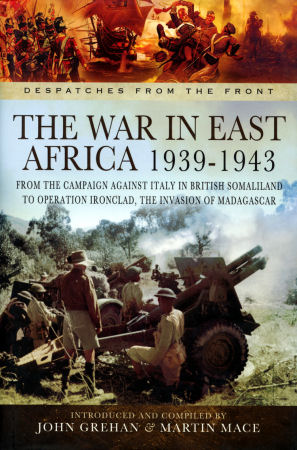
The War in East Africa 1939-1943 Book Review
By David L. Veres
| Date of Review | April 2016 | Title | The War in East Africa 1939-1943 |
|---|---|---|---|
| Author | John Grehan, Martin Mace | Publisher | Pen & Sword |
| Published | 2016 | ISBN | 9781783462230 |
| Format | 253 pages, hardbound | MSRP (USD) | $39.95 |
Review
The liberation of Ethiopia during World War II helped incubate Allied strategy, tactics and technology that eventually defeated Axis powers.
The seizure of Madagascar – Operation Ironclad – also secured the western Indian Ocean from enemy encroachment.
Now Pen & Sword chronicles both campaigns through official documentation in The War in East Africa 1939-1943 – part of the publisher’s “Despatches [Dispatches] from the Front” series, available in North America from Casemate.
Contents commence with Gen Sir Archibald P Wavell’s 18-page dispatch on Fascist Italy’s conquest of British Somaliland – Mussolini’s only strategic victory of the war. His second summary on Ethiopian operations, November 1940 to July 1941, follows. This consumes the bulk of the book – 153 of 253 pages – and includes Lt Gen Sir William Platt’s and Lt Gen Alan B Cunningham’s after-action accounts.
All condense East African combat chronology through major skirmishes and battles – including Massawa, Keren, Debra Tabor, Gondor, Debra Markos and Addis Abeba [sic: Ababa].
Familiar personalities also emerge. You’ll meet, for instance, Orde Wingate – and the legendary Gideon Force. Wingate’s innovations helped sow the seeds of today’s asymmetrical and irregular warfare practices.
Politics played roles, too. British commanders juggled Commonwealth contributions, Ethiopian forces and international considerations. Here, notes on the kabuki dance between victorious Allied forces in Ethiopia and blockaded, Vichy-ruled French Somaliland proved particularly intriguing.
Liberation of Ethiopia and conquest of former Italian colonies brought a brief period of pacification. And occupying forces juggled issues like reconstruction, repatriation, embusqués and essential services.
But conflict in the Pacific renewed “the threat of war to the East African coast.” And operations against Madagascar soon aimed at eliminating possible Vichy collusion with Japan.
That’s where the last two sections of this useful study continue: dual dispatches by Lt Gen Platt (East Africa, July 1941 to January 1943) and Rear Adm E N Syfret (the Capture of Diego Suarez during Operation Ironclad).
Some concerns intrude. Explanatory apparatus – like footnotes or glossaries – would help. What, for instance, are “‘I’ tanks”? Infantry tanks? And would novices know what “M.T.” and “O.P.” mean? The book’s only annotations, in fact, appear in Lt Gen R G Sturges’ addendum to Rear Adm E N Syfret’s dispatch.
Additionally, why no maps for geographic perspectives on action accounts? And how about some official documentation on the fascinating roles of Allied and enemy air assets in East Africa and Madagascar? Only occasional comments – and one lone appendix – note airpower contributions.
None of this, however, detracts from the value of this book. Most people – including World War II enthusiasts – don’t realize that Addis Ababa was the first Allied capital liberated during the conflict.
Learn how – through the prism of these official dispatches.
Recommended!
With thanks to Casemate for the review copy.







